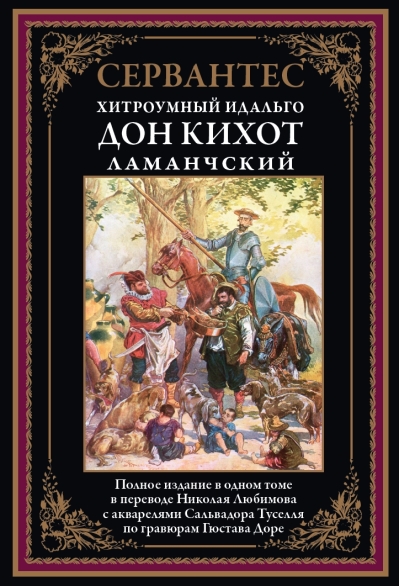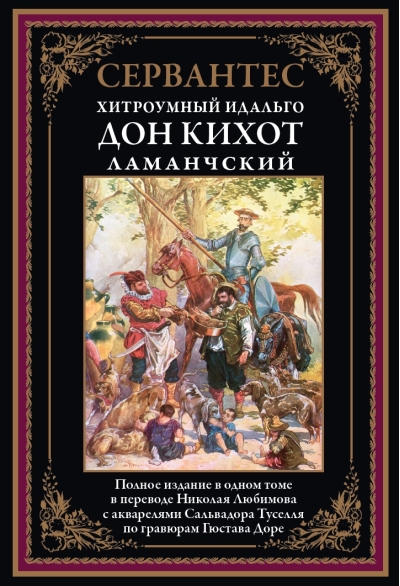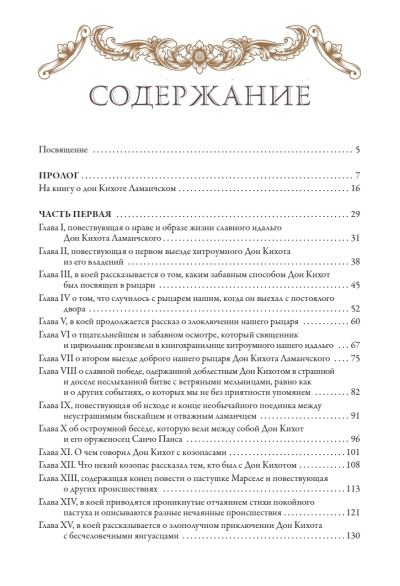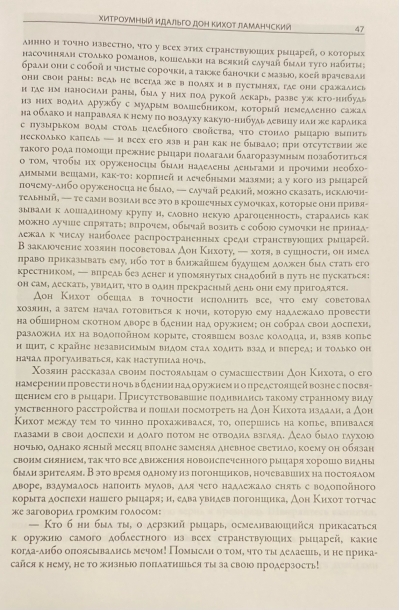The Cunning Hidalgo Don Quixote of La Mancha
39.99 €
In stock
The novel "The Cunning Hidalgo Don Quixote of La Mancha" by Miguel de Cervantes (circa 1547-1616) is part of the golden fund of world literature. The first full translation of the novel into Russian from Spanish was made in the early XX century. This edition publishes a brilliant translation by Nikolai Mikhailovich Lyubimov (1912-1992). Hundreds of color watercolors by Salvador Tucell, based on the engravings by the famous Gustave Doré, add to the extraordinary colorfulness and uniqueness of the edition.
The protagonist of the famous novel by Miguel de Cervantes has long been a kind of archetype, which has been repeatedly addressed not only by artists, directors, composers, cinematographers, but also by psychologists. In some ways, Don Quixote's twin is Prince Myshkin, because only being not quite in his right mind can alone throw himself at the mills of world evil and injustice. Initially, "Don Quixote" was conceived as a parody of chivalric novels, but the literary genius of Cervantes raised this work to an unprecedented height, in which laughter at the adventures of an amusing hidalgo turns into a bitter sneer at the eternal human vices. The author of "Don Quixote" and himself a little reminiscent of his famous literary hero. One of the biographers of Cervantes described him as a windy man, a dreamy poet who lacked worldly savvy and the ability to capitalize on his works. He was in love with everything beautiful, generous and noble. Life Cervantes, one of the seven children of impoverished nobleman, was full of severe hardships and hardships. However, despite the many trials and poor financial situation, he continued to write. Cervantes did not let the pen out of his hand literally until his dying hour. This was his literary feat. In our time, his name is written in golden letters in the history of not only European, but also world literature.
In this edition, the famous satirical novel by Cervantes is illustrated with watercolors by Spanish artist Salvador Tucell, who lived and worked at the turn of the XIX and XX centuries. Tucell made his drawings from engravings by Gustave Doré (1832-1883), who became one of the most prominent masters of book illustration of the XIX century. Doré executed the drawings for Don Quixote in 1863. By then he was already at the height of his fame. His innate talent for drawing Gustave honed in the halls of the Louvre and the National Library - copied the works of recognized masters, studied their techniques and style. Dore began drawing at the age of five, at school his notebooks were full of drawings and caricatures. Gustave was only fifteen, when the first album of his lithographs - "The Feats of Hercules". Thanks to the masterfully transmitted game of light and shadow Dore's work is instantly recognizable. During his life, the artist managed to illustrate dozens of books, including the famous poem by Dante, the Bible, fairy tales by Charles Perrault, the adventures of Baron Munchausen and other famous works. Critics rightly rank Dore among the greatest illustrators of the XIX century.
The protagonist of the famous novel by Miguel de Cervantes has long been a kind of archetype, which has been repeatedly addressed not only by artists, directors, composers, cinematographers, but also by psychologists. In some ways, Don Quixote's twin is Prince Myshkin, because only being not quite in his right mind can alone throw himself at the mills of world evil and injustice. Initially, "Don Quixote" was conceived as a parody of chivalric novels, but the literary genius of Cervantes raised this work to an unprecedented height, in which laughter at the adventures of an amusing hidalgo turns into a bitter sneer at the eternal human vices. The author of "Don Quixote" and himself a little reminiscent of his famous literary hero. One of the biographers of Cervantes described him as a windy man, a dreamy poet who lacked worldly savvy and the ability to capitalize on his works. He was in love with everything beautiful, generous and noble. Life Cervantes, one of the seven children of impoverished nobleman, was full of severe hardships and hardships. However, despite the many trials and poor financial situation, he continued to write. Cervantes did not let the pen out of his hand literally until his dying hour. This was his literary feat. In our time, his name is written in golden letters in the history of not only European, but also world literature.
In this edition, the famous satirical novel by Cervantes is illustrated with watercolors by Spanish artist Salvador Tucell, who lived and worked at the turn of the XIX and XX centuries. Tucell made his drawings from engravings by Gustave Doré (1832-1883), who became one of the most prominent masters of book illustration of the XIX century. Doré executed the drawings for Don Quixote in 1863. By then he was already at the height of his fame. His innate talent for drawing Gustave honed in the halls of the Louvre and the National Library - copied the works of recognized masters, studied their techniques and style. Dore began drawing at the age of five, at school his notebooks were full of drawings and caricatures. Gustave was only fifteen, when the first album of his lithographs - "The Feats of Hercules". Thanks to the masterfully transmitted game of light and shadow Dore's work is instantly recognizable. During his life, the artist managed to illustrate dozens of books, including the famous poem by Dante, the Bible, fairy tales by Charles Perrault, the adventures of Baron Munchausen and other famous works. Critics rightly rank Dore among the greatest illustrators of the XIX century.
See also:
- All books by the publisher
- All books by the author
- All books in the series Library of World Literature

































